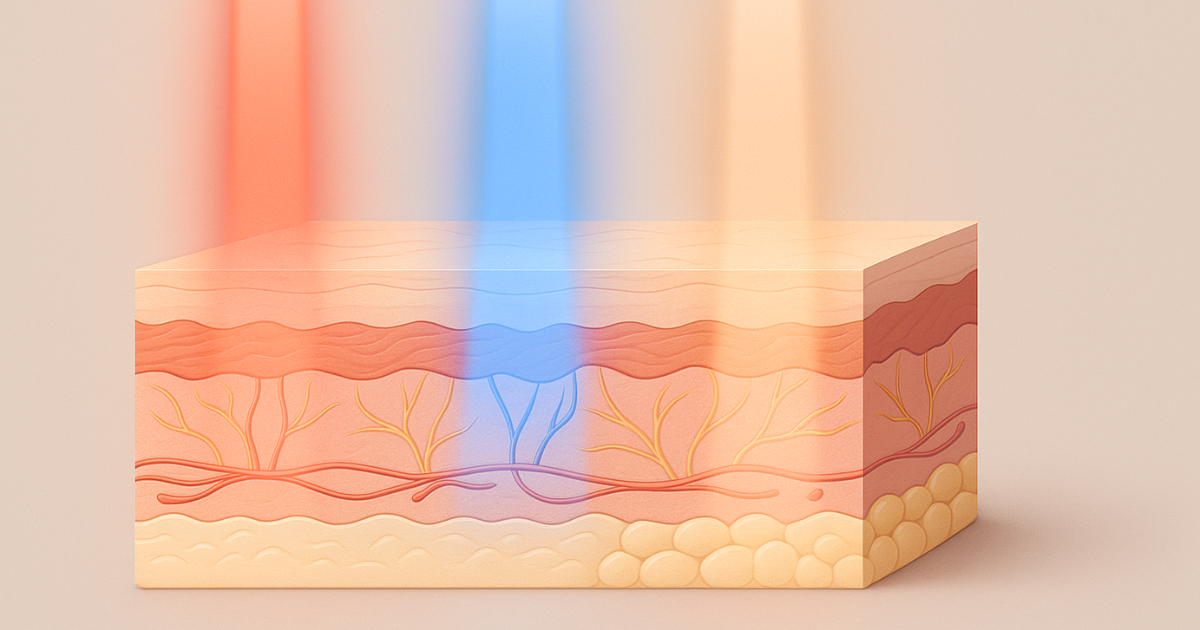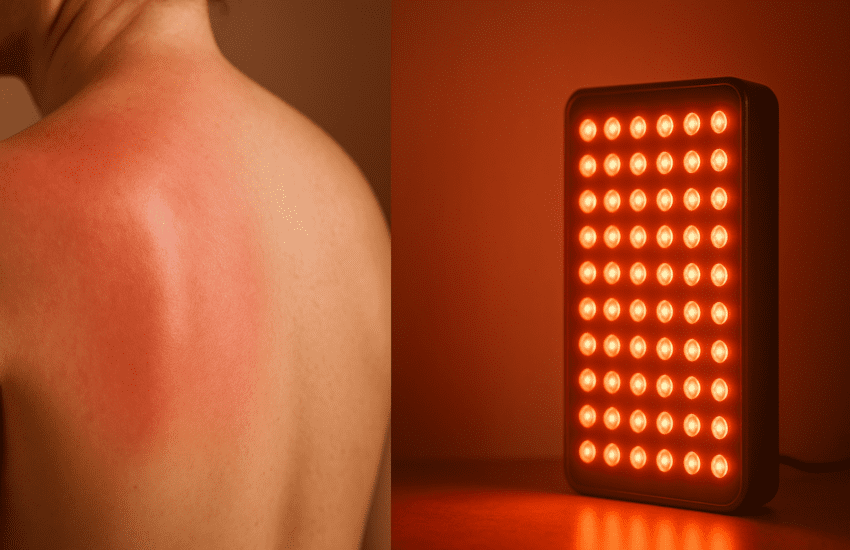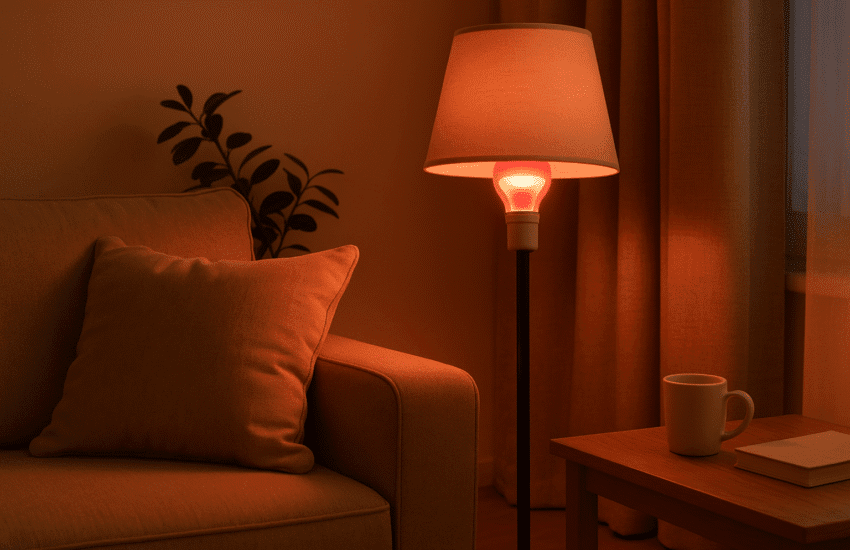LED Skin Phototherapy Treatments: Red, Blue & Near-Infrared Benefits Explained
LED skin phototherapy has revolutionized the skincare industry, offering a non-invasive, painless way to address various skin concerns. This technology, originally developed by NASA for plant growth experiments in space, has found its way into the beauty world with remarkable results.
What Is LED Light Therapy? How It Works
LED therapy uses specific wavelengths of light to penetrate the skin at different depths, triggering cellular responses that lead to various skin benefits. Each color of light targets different skin issues:
Red Light (620-750 nm): Collagen, Elasticity & Fine Lines
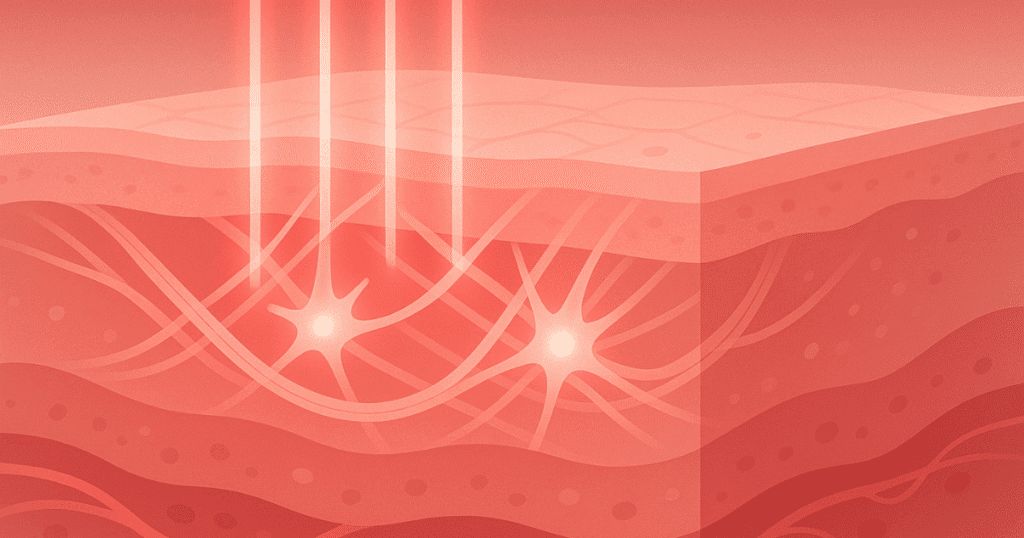
Red light therapy stimulates collagen production, which is crucial for maintaining skin elasticity and reducing the appearance of fine lines and wrinkles. It penetrates deep into the skin, reaching the dermis where collagen-producing cells called fibroblasts reside.
When exposed to red light, these fibroblasts kick into high gear, producing more collagen and elastin.
This increased production leads to firmer, plumper skin that looks more youthful. Red light therapy also improves blood circulation, ensuring that skin cells receive adequate oxygen and nutrients for optimal health.
Blue Light (415-495 nm): Acne Bacteria & Sebum Regulation
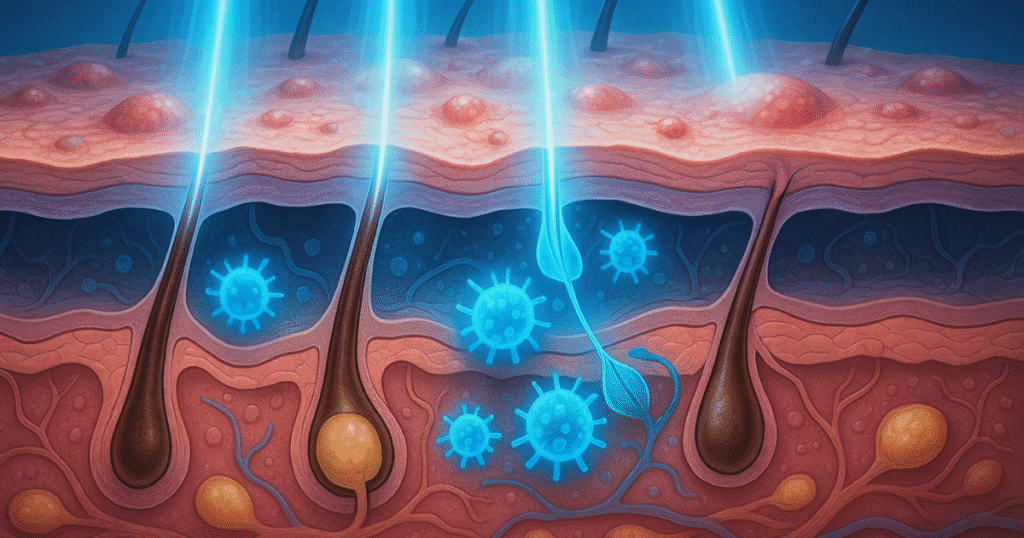
Blue light therapy targets Cutibacterium (Propionibacterium) acnes in follicles, helping clear active breakouts and reduce future congestion.
Blue light therapy also helps regulate sebum production, which is often overactive in acne-prone skin. By reducing excess oil, it helps prevent pores from becoming clogged, a common cause of acne breakouts.
Unlike many topical acne treatments, blue light therapy doesn’t dry out the skin or cause irritation, making it suitable for people who have sensitive skin.
Near-Infrared Light (750-1200 nm)
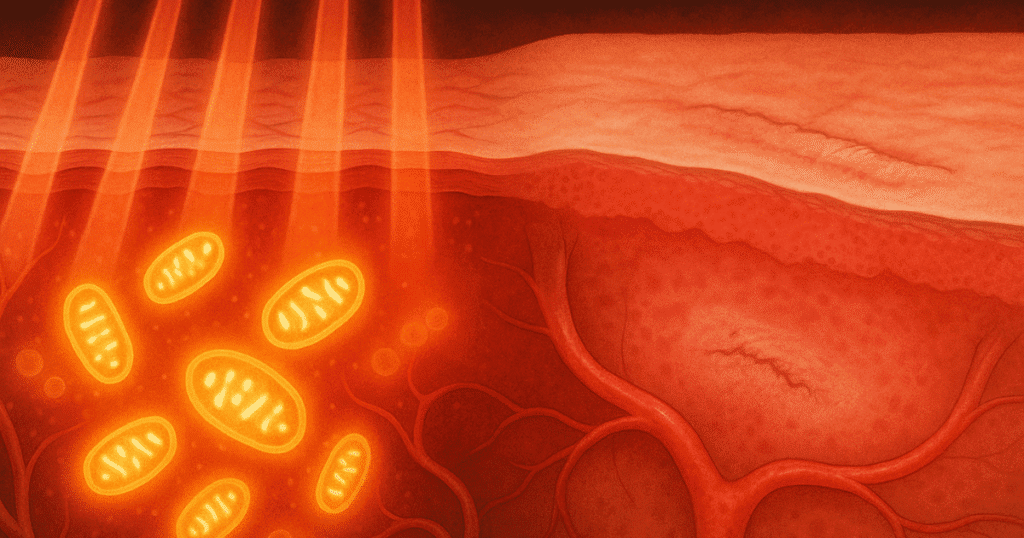
Near-infrared light penetrates the deepest of all LED therapies, reaching into the hypodermis. This wavelength primarily works on a cellular level, boosting the production of adenosine triphosphate (ATP), the energy currency of cells.
Increased ATP production leads to faster cell turnover and repair, which is particularly beneficial for wound healing and reducing the appearance of scars. Near-infrared light also has potent anti-inflammatory properties, making it effective for treating conditions like rosacea and reducing overall skin inflammation.
Professional vs At-Home LED Devices (Safety, Power & Results)
LED therapy can be incorporated into your skincare routine in several ways, depending on your specific needs and preferences.
Professional Treatments
Professional LED treatments are typically performed in a dermatologist’s office or a high-end spa. These treatments use powerful, medical-grade LED devices that deliver intense, targeted light therapy.
A typical session lasts about 20-30 minutes, and a series of treatments is usually recommended for optimal results.
Professional treatments offer several advantages:
- Higher intensity: Professional devices are more powerful than at-home options, potentially leading to faster results.
- Customization: A skincare professional can tailor the treatment to your specific skin concerns, combining different wavelengths as needed.
- Complementary treatments: LED therapy can be combined with other professional treatments like chemical peels or microdermabrasion for enhanced results.
- Expert guidance: A skincare professional can watch your progress and adjust the treatment plan as needed.
At-Home Devices
At-home LED devices have become increasingly popular, offering convenience and cost-effectiveness for those who want to incorporate LED therapy into their daily skincare routine. These devices come in various forms, including masks, handheld wands, and panels.
While not as powerful as professional equipment, at-home devices can still provide significant benefits when used consistently. They’re particularly useful for maintaining results between professional treatments or for addressing mild skin concerns.
When choosing an at-home device, consider the following:
- FDA clearance: Look for devices that have been cleared by the FDA for safety and efficacy.
- Wavelength options: Some devices offer many wavelengths, allowing you to target different skin concerns.
- Treatment area: Consider whether you want to treat your entire face or focus on specific areas.
- Ease of use: Choose a device that fits comfortably into your lifestyle and skincare routine.
Combining LED Therapy with Other Skincare Treatments
LED therapy works well in conjunction with other skincare treatments and products. Here are some effective combinations:
- LED therapy after chemical peels: Red or near-infrared light can help soothe the skin and promote faster healing after a chemical peel.
- LED therapy with serums: Apply your favorite serums before LED therapy. The light can help drive active ingredients deeper into the skin for enhanced efficacy.
- LED therapy after microneedling: Near-infrared light can help reduce inflammation and promote healing after microneedling treatments.
- LED therapy with sheet masks: Use an LED device over a sheet mask for an extra boost of hydration and nourishment.
Remember to always apply skincare products before LED therapy, as the light can help enhance their absorption and effectiveness.
Maximizing the Benefits of LED Therapy
To get the most out of your LED therapy treatments, keep in mind the following:
Consistency is Key
LED therapy works cumulatively, meaning that regular treatments over time yield the best results. Whether you’re using a professional or at-home device, consistency is crucial.
Set a regular schedule for your treatments and stick to it.
For at-home use, many devices recommend daily treatments of 10-20 minutes. For professional treatments, a series of weekly sessions is often recommended, followed by monthly maintenance treatments.
Be Patient
While some people may notice immediate improvements in their skin after LED therapy, significant results typically take time to develop. It may take several weeks or even months of consistent use to see substantial changes in your skin.
To stay motivated during this process:
- Take progress photos: Regular photos can help you track subtle changes that might not be immediately noticeable in the mirror.
- Keep a skin journal: Note any changes you observe in your skin, including texture, tone, and specific concerns like acne or fine lines.
- Remember that skin renewal takes time: The skin’s natural renewal cycle is about 28 days, so give your skin time to respond to the treatment.
Adapt Your Routine to Your Skin’s Needs
One of the advantages of LED therapy is its versatility. You can adjust your treatment routine based on your skin’s changing needs:
- Seasonal adjustments: In summer, you might focus more on blue light therapy to combat increased oil production and prevent breakouts. In winter, red light therapy can help combat dryness and boost your skin’s natural glow.
- Targeting specific concerns: If you have an important event coming up, you might increase your red light sessions for a collagen boost and that coveted “glass skin” effect. If you’re dealing with a stress-induced breakout, blue light can help calm inflammation and kill acne-causing bacteria.
- Combining wavelengths: Many professional treatments and some at-home devices allow for the combination of different wavelengths. For example, combining red and blue light can help address both acne and signs of aging simultaneously.
Protect Your Eyes
While LED therapy is generally safe for the skin, the bright light can be harmful to your eyes. Always use the protective eyewear provided with your device or during professional treatments.
If you’re using an at-home mask-style device, confirm it’s designed to block light from reaching your eyes.
Maintain a Healthy Lifestyle
LED therapy works best when combined with a healthy lifestyle. To maximize the benefits:
- Stay hydrated: Proper hydration is essential for healthy skin.
- Eat a balanced diet: A diet rich in antioxidants, vitamins, and minerals supports skin health from the inside out.
- Get enough sleep: Sleep is when your skin does much of its repair work.
- Protect your skin from sun damage: Always use sunscreen and avoid excessive sun exposure.
- Manage stress: High stress levels can negatively impact your skin health.
Advanced Techniques and Considerations
As you become more familiar with LED therapy, you might want to explore some advanced techniques:
Layering Wavelengths
Some advanced LED devices allow for the layering of different wavelengths. This technique can provide many benefits in a single session.
For example:
- Red + Blue: This combination can address both acne and signs of aging simultaneously.
- Red + Near-Infrared: This pairing can boost collagen production while also promoting deeper healing and reducing inflammation.
- Blue + Near-Infrared: This combination can help treat acne while also reducing associated inflammation and redness.
Targeted Treatments
While full-face treatments are common, you can also use LED therapy to target specific areas of concern:
- Crow’s feet: Use red light to stimulate collagen production around the eyes.
- Acne-prone areas: Focus blue light on areas prone to breakouts, like the T-zone.
- Hyperpigmentation: Use red light to help fade dark spots and even out skin tone.
- Lip area: Red light can help stimulate collagen production around the mouth, potentially reducing fine lines.
Combining with Active Ingredients
Certain skincare ingredients can enhance the effects of LED therapy:
- Vitamin C: This antioxidant can boost the collagen-stimulating effects of red light therapy.
- Retinol: Using retinol in conjunction with red light therapy can enhance its anti-aging effects.
- Hyaluronic Acid: This hydrating ingredient can help soothe the skin and enhance the plumping effects of red light therapy.
- Niacinamide: This ingredient can help strengthen the skin barrier and enhance the overall health of your skin when used with LED therapy.
Post-Treatment Care
After LED therapy, your skin may be more receptive to skincare products. Consider applying a nourishing serum or moisturizer immediately after treatment.
Avoid using harsh exfoliants or active ingredients like retinol immediately after LED therapy, as your skin may be more sensitive.
Potential Side Effects and Precautions
LED therapy is generally considered safe for most people, but there are some potential side effects and precautions to be aware of:
Mild Side Effects
Some people may experience mild, temporary side effects from LED therapy, including:
- Redness: This usually subsides within a few hours.
- Mild swelling: This is typically minimal and short-lived.
- Dryness or tightness: This can often be addressed with a good moisturizer.
- Temporary darkening of pigmented areas: This usually subsides on its own.
Precautions
Certain individuals should exercise caution or avoid LED therapy:
- Those with photosensitivity: If you have a condition that makes you sensitive to light, ask a dermatologist before trying LED therapy.
- People taking certain medications: Some medications can increase light sensitivity. Check with your doctor if you’re unsure.
- Those with active skin infections: It’s best to wait until the infection has cleared before undergoing LED therapy.
- Pregnant women: While there’s no evidence that LED therapy is harmful during pregnancy, it’s always best to err on the side of caution and talk to your doctor.
- People with certain eye conditions: If you have a history of eye problems, ask an ophthalmologist before using LED therapy, especially devices that are used near the eyes.
People Also Asked
What is LED light therapy for skin?
LED light therapy uses different wavelengths of light to treat various skin concerns. It’s a non-invasive treatment that can help with acne, aging signs, and inflammation.
How often should you do LED light therapy?
The frequency of LED light therapy depends on the device and your skin concerns. Professional treatments are typically done 1-3 times a week, while at-home devices can often be used daily.
Can LED light therapy damage your skin?
When used correctly, LED light therapy is considered safe and doesn’t damage the skin. However, it’s important to follow the instructions and not overuse the treatment.
How long does it take to see results from LED light therapy?
Results can vary, but many people start to see improvements after 4-6 weeks of consistent use. More significant results may take 8-12 weeks or longer.
Is red or blue light better for skin?
Red and blue lights target different skin concerns. Red light is better for anti-aging and collagen production, while blue light is more effective for acne treatment.
Can I use LED light therapy with retinol?
Yes, LED light therapy can be used with retinol. However, it’s best to apply retinol after the LED treatment, not before.
Does LED light therapy help with hyperpigmentation?
Red LED light therapy may help reduce hyperpigmentation by promoting cell turnover and improving overall skin tone.
Is LED light therapy safe for all skin types?
LED light therapy is generally safe for all skin types. However, those with certain conditions or taking specific medications should ask a dermatologist first.
Can LED light therapy replace my regular skincare routine?
LED light therapy should complement, not replace, your regular skincare routine. It works best when combined with a good cleansing, moisturizing, and sun protection regimen.
How does LED light therapy compare to laser treatments?
LED light therapy is gentler and has no downtime compared to laser treatments. However, lasers may provide more dramatic results for certain skin concerns.
Key Takeaways
- LED therapy uses different light wavelengths to address various skin concerns.
- Consistency and patience are crucial for seeing results from LED therapy.
- LED therapy can be done professionally or at home with the right devices.
- Combining LED therapy with suitable skincare products can enhance results.
- While generally safe, some precautions should be taken when using LED therapy.
